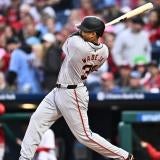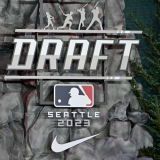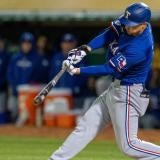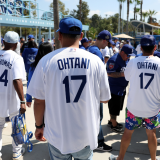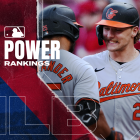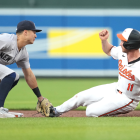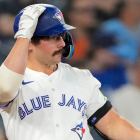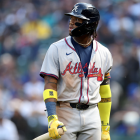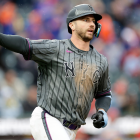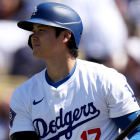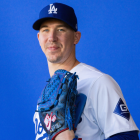 |
| The Rays' nucleus is strong. But how strong? (Getty Images) |
As your baseball advent calendar has informed you, pitchers and catchers will report in less than a month. Once the blessed occasion of spring training has arrived, we’ll be exhaustively analyzing your favorite team and those 29 other, lesser squads.
Until then, we have plenty of time to look ahead. Big market or small, each club has what it has determined to be the "core" of the franchise for seasons to come. And up until those pitchers and catchers emerge from winter slumber, we’ll be taking a look at each franchise and the state of its core.
What's a core? For our purposes, a team's core comprises a "cornerstone player," a "face of the franchise" (we'll explain our criteria in just a moment), and then the "future face of the franchise."
So what's a "cornerstone player"? For starters, it's one of the best players on the roster and perhaps the very best player on the roster. Beyond that, though, it's the player whom the organization has identified as the talent around which to build by signing him to a long-term deal. In other words, they've backed their faith in the player's abilities with the most powerful statement of all: redeemable U.S. currency and lots of it. Not only do they see this player as central to their current aims but also to their designs on future contention.
What's a "face of the franchise"? He -- and we're getting subjective here -- is the player who most prominently embodies the franchise in question. He's whom you think about when you think about this team. Is he the same guy as the "cornerstone"? Sometimes. But the cornerstone is primarily a financial designation. The "face" is, for lack of a better term, a cultural identifier. They're not mutually exclusive, but they're not not mutually exclusive, either.
What about the word "values" you see in the headline above? After we identify and evaluate the three elements of the the core, we're going to slap a letter grade on the whole thing.
So, armed with all that we need to safely venture into the smoldering core of the Tampa Bay Rays, let's light this candle ...
Cornerstone player(s): Evan Longoria
The Rays enjoyed several seasons of drastically below-market value from Longoria, thanks to their wise and bold decision to sign him to a six-year, $17.5 million contract extension in April 2008 (mere days after his major-league career had begun). Remember when John Hart blazed a trail by signing young Cleveland Indians to long-term deals during the early seasons of their careers? The Rays moved similarly in the early moments of Longoria's career.
Most recently, the Rays ramped up their investment. They signed Longoria to a second extension, this one for $100 million over six years. Since the deal doesn't kick in until his current contract expires, Longoria will be locked up through at least 2022. That's an investment and statement of confidence, particularly from a franchise Forbes ranks 29th in overall value.
As for whether Longoria will live up to his second contract extension, it largely depends on health. We know what Longoria can do when in fighting shape (career slash line of .276/.361/.516, OPS+ of 137, two 30-homer seasons and a pair of Gold Gloves), but he has lost almost a full season's worth of games to injury in his young career. Longoria's ability to stay healthy will determine whether he'll be a truly great player across what should be his prime seasons.
According to the very rough estimates of FanGraphs, Longoria has provided the Rays with $128 million in value over the span of his career and has done that while being paid an absurdly nominal $8.5 million. The Rays certainly won't enjoy such deep discounts moving forward, but Longoria -- again, if blessed with health -- absolutely has the skill set to continue giving the Rays outstanding value on the dollar. He is indeed the cornerstone.
Face(s) of the franchise: David Price
The affable and decorated Price (your 2012 AL Cy Young winner!) is unquestionably on the short list of best pitchers in baseball. That he toils for a team known to thrive on run prevention is fitting. In another sense, he also embodies what the Rays have become.
Tampa Bay in part rose to prominence because of the high draft picks it hoarded during and as a consequence of the otherwise dismal Chuck LaMar years. Price, a Vanderbilt product, was the top overall pick of the 2007 draft -- roughly a year and a half after LaMar was fired as GM. He emerged as a genuine major-league ace at the age of 24 (208 2/3 innings, 144 ERA+ in 2010), and he has been that ever since. When you think of the Rays, you're likely to think of starting pitching. And when you think of the Tampa Bay rotation, you'll surely think of Price, the face of the Rays. The matter soon to be at hand, though, is how long Price will be the face of the franchise.
Face(s) of the future: Wil Myers
Longoria obviously isn’t going anywhere, but what about once his decline phase takes hold? One could argue for young lefty Matt Moore, who is flush with potential and will be the Rays' ace in the post-Price years (he has also been "Longoria-ed" by the organization, signed to a five-year, $14 million pact just 9 1/3 innings into his major-league career). But Myers has the most offensive upside of any player in the organization. If he develops as the Rays hope, then the trade that brought him to Tampa Bay will reinforce a host of perceptions -- to wit, that the Rays never hesitate to deal from a position of strength, lean heavily on cost-controlled talent and take a thoroughly different approach to building a roster than, for instance, the Royals.
In some senses, the power-hitting Myers (.600 SLG and 37 homers across Double- and Triple-A last season) will embody the Rays' organizational mindset even if he flops. He'd then become the embodiment of their market limitations once those core high draftees are either wearing someone else's uniform (Price, almost certainly) or are trapped in their decline phases (Longoria at some point). For good or ill, Myers will help write the Rays' story in the coming seasons.
Nucleus moving toward the future …
Longoria, Moore and Myers are under team control for years to come. Price will be arbitration-eligible in 2014 and 2015 and eligible for free agency in 2016, so a trade during those salary-leap years is possible. Because of Price's age (27) and laurels (three-time All-Star in addition to that Cy trophy), it's hard to imagine him spending the entirety of his career with Tampa Bay.
Another core contributor, Ben Zobrist, is locked up through 2015, and Desmond Jennings isn't eligible for free agency until 2018. Matt Joyce? Arb-eligible until 2016. Given the likelihood of Price's eventual departure, do the Rays move to lock up Jeremy Hellickson? It would be a very Rays thing to do (read: a very smart thing to do). On the horizon are also minor-league talents like shortstop Hak-Ju Lee (who, if he evolves, will fill a need of long standing) and, as you might expect, a number of high-ceiling arms.
In other words, expect the Rays to continue vying for playoff berths despite playing an unbalanced schedule in a hostile division and despite the limitations of their market and budget.
Rays' Core Value: A
On Monday, we'll ruthlessly assess the Core Values of the New York Mets ...
For more baseball news, rumors and analysis, follow @EyeOnBaseball on Twitter, subscribe to the RSS feed and "like" us on Facebook.








